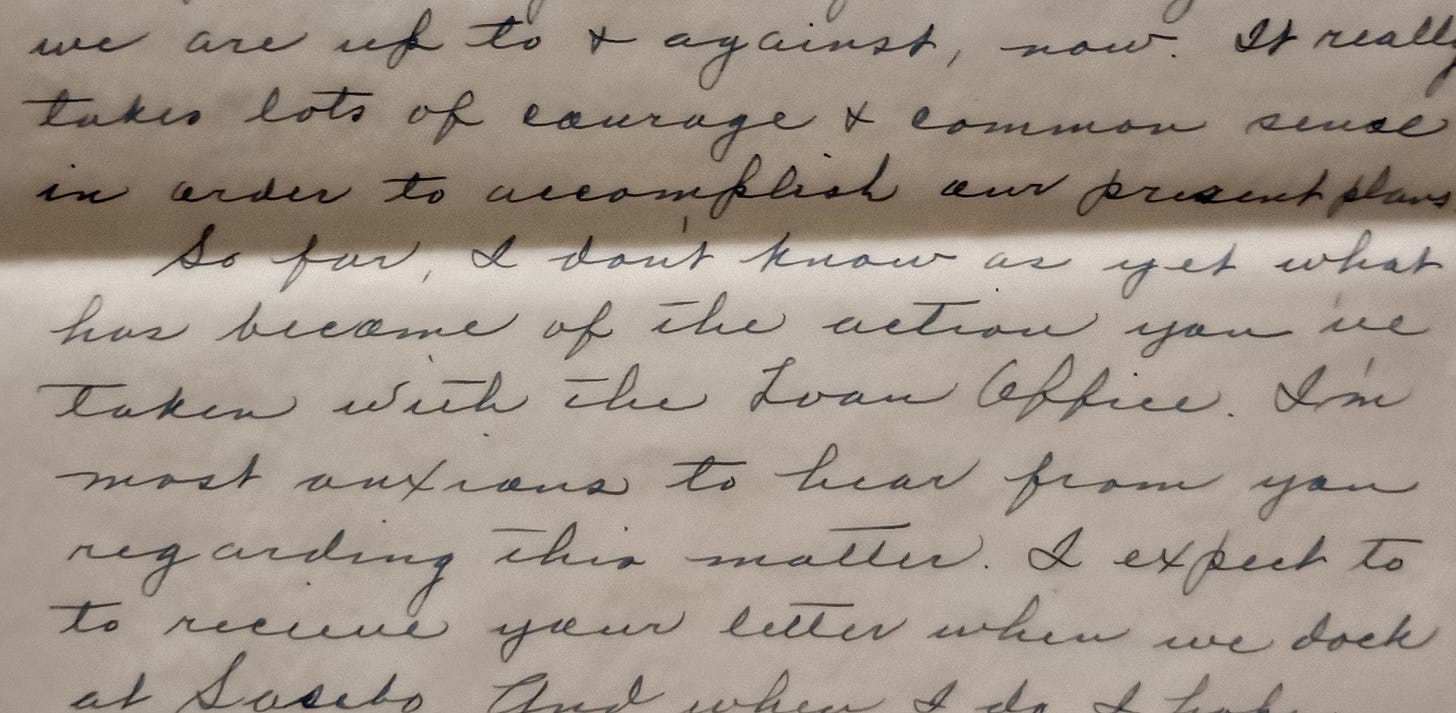The Bootstrapping Myth
#181: Then & Now, Art, Christopher T Wood, Lenore Tawney, Exquisite Corpse, Jeremy Mathews, Butch Dalisay, Nervous Systems Blog, Dale M Reid, Nicholas Bernhard (payphones), Bernie Krause, & Jinsan Kim
THEN & NOW
Bootstrapping?
The events I’ve been narrating about my parents’ efforts to acquire their dream home are starting to sound like the “bootstrap” immigrant narrative. I suspect that the bootstrap myth had penetrated my parents’ thoughts. It goes like this: Through hard work and sacrifice, you “pull yourself up by your bootstraps” and eventually succeed in achieving your goals, whether it’s buying and owning a home, building a business, or a career. I don’t want to denigrate my parents’ hard work or dreams. However, if you think about it, the term doesn’t work well as a metaphor. In any case, we ended up deviating from that immigrant narrative in many ways, especially during the late 1960s, which disrupted a lot of postwar goals and trajectories.
In July 1953, Dad’s letter discussed how important the idea of owning their own house was to them.
It really takes lots of courage and common sense in order to accomplish our present plans.
So far, I don’t know as yet what has become of the action you’ve taken with the Loan Office. I’m most anxious to hear from you regarding this matter. I expect to receive your letter when we dock at Sasebo. And when I do, I hope, I’ll find sign of favorable negotiations that will eventually contribute to the success of what we longed for. I know it would make you exceedingly happy if that dreamhouse will finally be acquired. Then you and I and our little Jean, we will move in and live happily thereafter, I hope.
Dad’s August 1953 letter revealed that he had suffered a leg injury. Yet he was putting in long hours and had contracted for an extra voyage, though it sounded like he needed a break. Somehow he worked through it, although he was “having a hard time due to long hours standing and walking while at work” and was “hoping and praying to God that I’ll be able to get by and finished [sic] this voyage without losing any [work hours].”
We need the dough very badly so I’ve decided to make this trip anyhow although I realized how hard it would be for my bum leg. I went to see our ship’s doctor before we departed to ask his advice but he told me that as long as I keep it bandaged . . . I’ll be able to make it . . . When we get back I’m going on sick leave.
In September of 1953, their home loan was approved. Mom and I moved into our prefabricated house on a corner lot. I remember nothing about the move itself; I think I was recovering from some illness. I do remember that the house was white with a bumpy stucco exterior. Other than that, everything in the area seemed to be brown and dusty; perhaps it was the legacy of the area having been a race track. I remember a large front yard with no lawn, and a wide street composed mostly of flattened dirt.
On both sides of Fair Avenue, large muddy ditches filled up with rain water. I once tied a string to a stick and went out to the water-filled ditch near our house, hoping I would hook a fish (I didn’t). I remember caravans of noisy shovel loader trucks and other heavy machinery dumping dirt onto the streets. It seemed like we lived with those alternately dusty / muddy roads for much too long. But finally sidewalks were created. Asphalt and stinking black tar were applied to the roads, and one day we had what looked like real streets. Suddenly we were living in suburbia—with a few exceptions. More on that in the next issue.
What we had left behind: San Francisco, 1950s (remastered by Vivid History):
Where we had ended up: Santa Cruz. This YouTube link takes you to an old Chamber of Commerce site promoting the city as a recreational haven.
But here’s a different view of Santa Cruz, from the perspective of its Chinese residents (narrated by George Ow, Jr.), Kathryn Phan channel:
Archives & Print Culture
I have transferred my Commonwealth Cafe Substack to its own section in Eulipion Outpost (see menu on the EO homepage). The Commonwealth Cafe reflects my interests in Filipino and AAPI print culture, history, and archival projects.
Some context: My bachelor’s thesis, submitted to UCSC in 1991, was about the trickster character (often embodied in the mouse deer, the monkey, or the foolish human Juan Tamad) depicted in satirical cartoons during 19th and early 20th century Philippine newspapers. Frequent targets of satire were Spanish friars representing the Spanish colonial regime in the Philippines, and later US government officials representing the colonial American government. My PhD dissertation at UC Berkeley focused on US Filipino literary history in West Coast [Filipino] periodicals published before WWII.
The Philippines has a long-standing history of newspaper publishing. When Filipinos migrated to the US, they immediately started producing small newspapers. I have counted forty Filipino newspapers published on the West Coast alone during the 1930s. Many of the publishers were working as farm laborers, labor contractors, or “service” workers. Most of the newspapers were short-lived, operating on a shoestring, sometimes published on spirit duplicators. Others were published thanks to the mutual aid of local progressive presses. This was the case between the Philippines Mail in Salinas and the (then) progressive Carmel Pine Cone in Monterey County in the 1930s. The newspapers served as an important community lifeline between the far-flung Filipino communities in the U.S.
You can learn more about the Philippines Mail in the first four issues of CC and in VOMB.
ART
Here are two examples of mail art (with asemic writing) I have made recently (the first was mailed, the second might still be in progress). I love the idea of creating these small art cards and sending them out like wide-ranging spores across the globe via the postal service.
RABBIT HOLE
I’m fascinated by Christopher T Wood’s “Daydrawing” project because it combines the small with the large. He has been doing a small graphite drawing everyday since 2016, so that the sum of all the drawings becomes an ever changing and expanding “hyperobject.”
Lenore Tawney’s weaving and mail art: Documentary: “Mirror of the Universe”:
How to see an exquisite corpse (AEON): “That idea of something both small in scale and like endlessly vast is a kind of surrealist provocation in itself.” — Lanka Tattersall. I was lucky to meet the Beat poet and surrealist Ted Joans1 at UC Berkeley, whose final exquisite corpse project is shown and discussed in this video. I did not know, back then, that he was also a visual artist.
From his newsletter The Patchwork Principle, Jeremy Mathews writes about “The Dollhouse Economy” and the importance of craft and material processes for artists.
I wish I had seen this article before I published my Tagalog vs. English issue. It’s by Butch Dalisay on the paradoxes of English language requirements in the Philippines. In any case, it’s definitely relevant.
The Nervous System Blog focuses on the relationship between design and natural phenomena, and features some of the most beautiful jigsaw puzzles ever. A fun site to explore.
This seems like it should be an art project. Is it? Working Colorado payphones project. By Nicholas Bernhard.
SOUNDINGS
Soundscape ecologist Bernie Krause began his audio career working on films like Apocalypse Now. Tired of the Hollywood grind after working on over 135 feature films, he shifted to recording natural world sounds in 1968. In this New Yorker documentary2 he discusses what natural sounds mean to him, and how the soundscape changed after a major fire he experienced in Sonoma County:
Thanks to Ficus Strangulensis on IUOMA for tipping me off to this truly amazing guitarist Jinsan Kim performing “Spy”:
My gratitude goes to everyone who reads Eulipion Outpost regularly, and especially to those who have subscribed or donated on my Ko-fi page to support my efforts.
My ongoing appreciation goes to the Mysterious M. for his excellent editing skills.
Website and blog: jeanvengua.com
A Crooked Mile (blog).
Eulipion Outpost is a reader-supported publication. To receive new posts and support my work, consider becoming a free or paid subscriber.
Joans struck me as a very kind and gracious person and a powerful poet.
Documentary film by Masha Karpoukhina.






Thank you Jean for sharing your parents communications through their intimate letter writings. They both had hope for better times together tempered by their long separations as your father's Merchant Marine work took him far away. I appreciate your writing about "the bootstrap mythology" regarding your parents trials in buying a 1950s Santa Cruz home. Their story would make a great movie.
Cathy
Very interesting. You're giving me ideas to crosscheck with the research I've done on my parents in approximately the same time period on opposite ends of this country in NY. I was born in the Philippines in September 1953 but was in NY a year and a half later. My mother was a nurse, too, and working then.